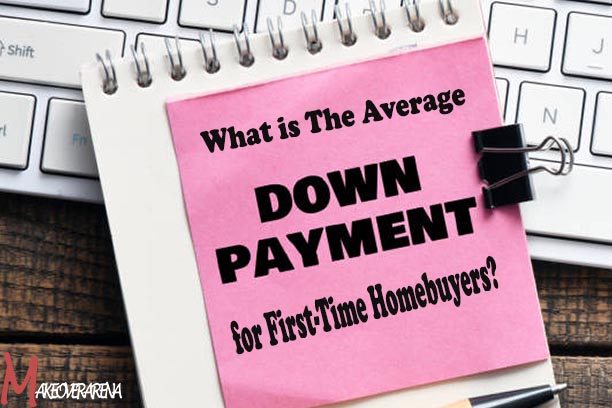What is the average down payment for first-time homebuyers? When embarking on the journey of purchasing a home, one crucial aspect that first-time homebuyers must consider is the down payment. A down payment is a substantial upfront payment made by the buyer as a percentage of the total purchase price.

It serves as a financial commitment and a means to secure a mortgage loan. In this article, we will delve into the average down payment for first-time homebuyers, exploring the factors that influence it and discussing strategies for saving towards this significant milestone.
What is a Down Payment?
A down payment is a substantial upfront payment made by the buyer when purchasing a home. It represents a portion of the total purchase price and is paid from the buyer’s own funds. The purpose of a down payment is two-fold. Firstly, it demonstrates the buyer’s financial capability and commitment to the home purchase, giving reassurance to lenders. Secondly, it reduces the lender’s risk by providing a stake in the property and decreasing the likelihood of default.
The required down deposit amount can vary depending on factors such as the loan program and the buyer’s financial situation. Conventional loans typically require a down payment ranging from 5% to 20% of the purchase price. Government-backed loan programs, like FHA loans or VA loans, often offer lower-down options.
It’s essential for first-time homebuyers to carefully consider their own amount, balancing the desire for a lower monthly deposit with the effort required to save up. Researching options and consulting with lenders can help determine the most suitable down amount for each individual’s circumstances.
Factors Influencing the Average Down Payment
Several factors contribute to variations in the average down deposit amount for first-time homebuyers. Let’s examine the key influencers:
Loan Type and Program
Different loan programs have varying down deposit requirements. Conventional loans, offered by private lenders, generally require a down payment of around 5% to 20% of the purchase price. FHA loans, insured by the Federal Housing Administration, often require a lower down payment, typically around 3.5%. Veterans may be eligible for VA loans, which often require no down payment at all. Other loan options, such as USDA loans or state-specific programs, also have unique down payment requirements.
Location and Housing Market Conditions
The average down payment can vary based on the location and prevailing housing market conditions. In regions with higher home prices, down payment percentages may be higher as well. Furthermore, market dynamics, including supply and demand factors, can impact down payment averages.
First time Homebuyer Assistance Programs
Various assistance programs exist to support first-time homebuyers in their homeownership journey. Down payment assistance programs provide financial aid to help cover a portion of the down payment. Additionally, grants and subsidies may be available for eligible individuals or families. Certain programs cater specifically to low-income individuals or veterans, offering specialized down payment support.
What is the Average Down Payment for First-Time Homebuyers?
The average down payment for first-time homebuyers varies depending on factors such as location, loan type, and market conditions. Typically, first-time buyers aim to contribute a down payment ranging from 3% to 10% of the home’s purchase price. However, it’s important to note that individual circumstances and loan programs can lead to higher or lower discharge requirements.
Conventional loans, which are not government-insured, often require down discharges ranging from 5% to 20% of the purchase price. Government-backed loan programs, such as FHA loans, commonly have a minimum down deposit requirement of 3.5%. For eligible veterans, VA loans may offer the opportunity to secure a mortgage loan with no down discharge at all.
Additional support for first-time buyers can be found through down-discharged assistance deposits and grants. These programs, available at different levels (local, state, or federal), provide financial aid to help bridge the gap between available funds and the required down payment amount.
Ultimately, it’s essential for prospective homebuyers to consult with lenders, explore available resources, and consider their individual circumstances to determine the most suitable down payment amount for their specific needs.
Strategies for Saving for a Down Payment
Saving for a down payment requires careful planning and financial discipline. Here are some strategies to consider:
- Establish a budget and savings plan to allocate funds specifically for the down payment.
- Reduce discretionary expenses and identify areas where spending can be minimized.
- Explore ways to increase income, such as taking on additional work or considering side gigs.
- Consider deposit assistance programs or explore options for gifts or loans from family members.
Conclusion
Understanding the average down payment for first-time homebuyers is essential when considering homeownership. It is influenced by factors like loan type, location, and available assistance programs. By exploring these factors and implementing effective saving strategies, prospective buyers can work towards their down payment goals. Remember, diligent financial planning and research will ensure a smoother transition into homeownership, setting the stage for a fulfilling and secure investment in the future.
FAQs
Can I Purchase a Home With a Down Payment Lower Than the Average?
Yes, it is possible to purchase a home with a down settlement lower than the average. While the average down settlement for first-time homebuyers ranges from 3% to 10%, there are loan programs available that allow for lower down deposits. For example, FHA loans often require a minimum down deposit of 3.5% of the purchase price.
Can I Make a Larger Down Payment Than the Average?
Absolutely. Making a larger down deposit than the average can have several advantages. A larger down deposit can help reduce the total loan amount and lower your monthly mortgage deposit. It can also demonstrate to lenders that you have a strong financial position and may potentially lead to more favorable loan terms, such as lower interest rates.
CHECK THESE OUT:



